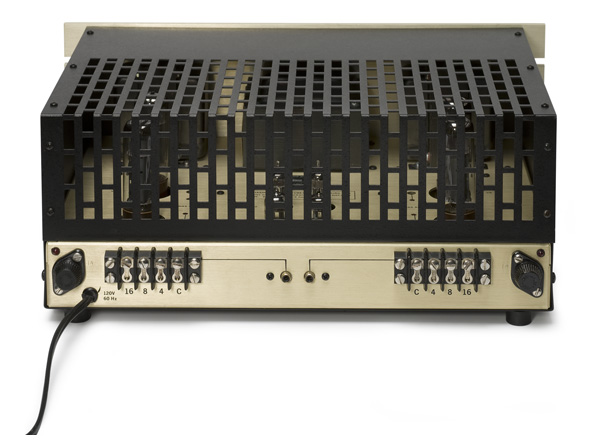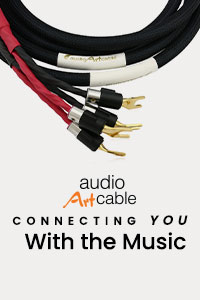Conrad-Johnson MV-50
 The MV 50 was one of Conrad-Johnson’s earliest vacuum-tube power amplifiers, utilizing EL34/6CA7 output tubes, with a modest power output of 45 watts per channel. As is the way at CJ, this design was steadily improved over the years in the form of the MV-52, MV-55, MV-60 (and the 60SE, which utilized 6550 output tubes for more power) to the recent LP-70 power amplifier, which also uses 6550s, and CJ’s latest CJD Teflon capacitors. More about those capacitors later.
The MV 50 was one of Conrad-Johnson’s earliest vacuum-tube power amplifiers, utilizing EL34/6CA7 output tubes, with a modest power output of 45 watts per channel. As is the way at CJ, this design was steadily improved over the years in the form of the MV-52, MV-55, MV-60 (and the 60SE, which utilized 6550 output tubes for more power) to the recent LP-70 power amplifier, which also uses 6550s, and CJ’s latest CJD Teflon capacitors. More about those capacitors later.
CJ’s first vacuum-tube power amplifier that used 6550 output tubes, the MV-75, was introduced in mid 1979,. The following year, they introduced the MV-45, which was an EL34-based amplifier. Both models then went through A and A1 revisions. The MV-50 was built from 1985 to 1990 and had a similar tube complement with an original retail price of $1,485. I was always a huge fan of CJ tube preamplifiers, starting with their PV-1. But from the beginning of my HiFi journey, I felt that a high-powered solid-state amplifier was required to get the job done. Chalk it up to owning and selling Phase Linear back in the late ’70s.
Shortly after I moved to Scottsdale, Arizona, in the late ’80s, a local HiFi dealer put the full-court press on me and insisted that I buy an MV-50, which sounded great in his shop driving a pair of Vandersteen 2Ci’s. My Spica TC-50’s didn’t need a lot of juice and I couldn’t play them terribly loud living in an apartment anyway, so I took the bait and brought home this stark-looking tube amplifier for the weekend. An hour later, after the tubes had fully warmed up, I was in heaven – the TC-50’s never sounded so good.
At the beginning of the week, I returned to the dealer with a wad of cash and my Adcom 555 in tow. Hard to believe that a 45-watt-per-channel amplifier with “less than one percent distortion at full output” would replace that monster solid-state amp, but I’d never been happier. It wasn’t long before a CJ PV-10 preamp was sitting on my rack to match the MV-50 amplifier, and I was a full-blown tube junkie. Like so many audiophiles, I had the itch to try something else, even though I didn’t realize there was some serious magic going on here, so the MV-50 went to a good friend. It’s worth mentioning that said “friend” tormented me for years about letting go of this little jewel…
Over the years, many other amplifiers have moved in and out of my sound room, but the memory of the MV-50 remained. I managed to find another one in excellent shape, which ended up mated to my PV-1 that had been sitting on the shelf for some time, but a good friend needed a budget system and once again, I became the Santa Claus of CJ.
About a year ago, CJ announced that they would be offering an upgrade path to select models utilizing their CJD Teflon capacitors, which looked intriguing. Seeing the MV-50 on the list, the hunt began. Fortunately, it didn’t take long until I was able to find a very clean MV-50 that had a “slight buzz” in the left channel. Should you decide to follow my lead and take this path, concentrate on cosmetics, as there are no remaining MV-50 front panels left in the CJ factory. Remember, it’s going in for service anyway.
Even though this particular MV-50 did have that buzz in the left channel, it sounded just as I remembered them, lush and inviting. Little did I know about the secret behind this amplifier. For on that later.
In 2003, CJ designed a series of Teflon capacitors for their products taking their traditional, slightly romantic tonality to a new level. None of the new products featuring these capacitors lost any of the midrange magic or tonal richness for which CJ is famous. But the new generation featured extension at both ends of the frequency spectrum that was not present before. In addition to more transparency, the newest CJ products have more dynamic contrast and impact. Combining the new capacitors, their latest wide-bandwidth output transformers and what they had learned in more than 30 years of amplifier design resulted in today’s series of LP power amplifiers.
Thanks to their commitment to build quality, many of their original amplifiers are still in service today. When I visited the factory in October, there were a number of vintage CJ amplifiers in for service and upgrades. Lew Johnson told me, “Many of our customers hang on to their old gear when they upgrade and use it in a second or even third system, so it made a lot of sense to offer the upgrade program.”
The MV-50 you see here was built in July 1987 and as you might expect, the electrolytic capacitors in the power supply are about at the end of their lives. So in addition to the C1 capacitor upgrade, I had the power supply rebuilt, too. Now featuring polypropylene capacitors in the power supply, all of the electrolytic capacitors are gone from the circuit. As I watched Lew and his senior tech Jeff Fischel measure a few things underneath the chassis, Jeff smiled and said, “With all film capacitors under the hood, this amplifier will easily last another 35 years, if not longer.”
The power-supply mod will add another $500 to the bill, but it’s well worth the expense. It would be a shame to spend the time and expense to have the Teflon capacitors installed only to have a power-supply failure at a later date. Shipping 60 pounds isn’t cheap, and every time you put that amplifier in a box, you run the risk of loss or physical damage. So I suggest taking care of everything while your amplifier is at the factory.
CJ is making every effort to turn the amplifiers around in about 7-10 working days. In addition to bench testing every upgraded amplifier, they spend some time listening to it in their sound room to make sure everything is right.
I’ve been listening to an MV-50 on and off for the past 25 years, so its overall sonic signature is burned into my memory: a seductive midrange that draws you in to the presentation, but a little bit rolled off on top with a slightly flabby bass response. But with a sufficiently efficient pair of speakers, you’d probably never notice. The folks at CJ were kind enough to put a few hours on the MV-50 before sending it back home, but as with any modern HiFi component that has Teflon capacitors in the circuit, it will take about 400-500 hours to realize its full sound potential. Out of the box, your “new” MV-50 will sound somewhat thin and you might even shake your head and wonder what happened to the magic that was in the amplifier you sent away. It’s there. It’s just going to take some time to return.
At about 250 hours, the amplifier will come out of its “fog” and the luscious midrange you remembered will return, improving steadily for the next 250 hours. As neither TONE nor CJ suggest leaving a tube power amplifier playing unattended, this may take you a bit longer than it would to fully break in a solid-state component. As this is probably 10 percent of the tubes’ rated lifetime, I would highly suggest procuring a cheapo set of EL-34’s for the first few hundred hours of the burn-in ritual.
Once you get over the hump of putting some hours on those new capacitors, the MV-50 is a completely different beast. While Lew reminded me that it does not possess the ultra-wide bandwidth output transformers of the current amplifiers, the improvement is so huge in every way, it’s tough not to be really excited. It’s kind of like putting a new crate motor with fuel injection in your vintage Camaro.
Best of all, the work was done at the factory by the people who build these amplifiers every day, not some hack who works in the basement. Johnson laughs as we discuss this. “You wouldn’t believe some of the stuff we’ve seen done to our amplifiers,” he said. “Some of it isn’t even safe. At that point, we have to call the customer and tell them what it will cost to undo what’s been done or we can’t even proceed.”
While using the new MV-50 was slightly overkill with CJ’s flagship GAT preamplifier that I heard in their sound room, this little amp wasn’t the least bit out of place driving a pair of Wilson Sophia’s. Even with the fresh Teflon caps, it possessed a greater degree of weight than any MV-50 I’d ever heard.
Fortunately, when the MV-50 arrived back on my doorstep, it was accompanied by the new CJ ET3 SE preamplifier, which is essentially a stripped-down version of the GAT with a TEA-2SE phono preamplifier built in. We have a full review in the works, but for $5,000, this is an amazing combination for the audiophile wanting the best CJ has to offer at a more-affordable price. The combination with the upgraded MV-50 proved to be out of this world.
If you start from scratch and seek out a used MV-50 to have updated, you should be able to find a clean example in the $700 to $900 range. Add another $1,500 to have the C1 capacitor upgrade and the power supply rebuilt and you will have a 45-watt-per-channel tube power amplifier that will be on par with (if not outperform) anything in that price category today.
Should another friend need a nice tube amp, they can find their own. This one is going to be buried with me.
Epilogue: A final word from Lew Johnson
Shortly after finishing my amplifier, I received an interesting email from Lew. Tracing the serial number more carefully, it turns out that this amplifier was the only MV-50 they sold to Esoteric Audio in July 1987. So after a long journey from Arizona to Chicago, and then to the East Coast, the MV-50 was found by me on the Audio Circle forum in Denver. After going on a trip to CJ and back, this amplifier should be on a frequent flier program! It’s certainly great to have it back.







